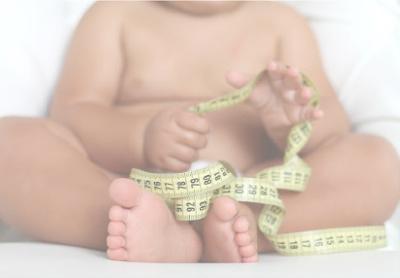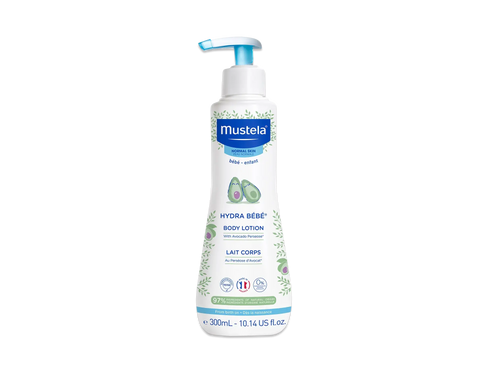As soon as you become a parent, your little one’s happiness and health become two of your top priorities in life. A baby growth chart is one way for you and your pediatrician to make sure that your little one is growing and gaining weight as they should.
If you’re confused about how to read a growth chart, don’t worry. They’re easy to use once you get the hang of it! Plus, knowing how to read them might make you feel more at ease about your baby’s development.
Here at Mustela, we’re diving in to help you figure it all out.
Table Of Contents
- What Is A Baby Growth Chart?
- Baby Growth Charts: The WHO And The CDC
- How To Read A Baby Growth Chart
- What Does Percentile Mean?
- Can Growth Charts Be Wrong?
- Other Factors That Affect Growth And Development
- What To Know About “Failure To Thrive”
- Ensuring Healthy Growth And Development
What Is A Baby Growth Chart?

Source: cdc.gov
A growth chart might look like random numbers and lines, but for someone who knows how to read it (that will be you soon!), it’s a valuable tool for understanding and tracking a child’s growth.
Baby growth charts are typically used to measure three things: your baby’s length, weight, and head circumference. Your pediatrician will take all three of these measurements each time you and your little one go in for a checkup.
These growth charts can be intimidating, but after reading this article you’ll feel more at ease! So, how are these measurements taken? Let’s take a look.
Length
Your baby’s length is the same as height. It’s the measurement from the top of their kissable head to the bottom of their tiny feet (their heels).
Your pediatrician will take this measurement with your baby lying down until they’re two years old. They’ll usually have to stretch your wriggling baby’s legs to get a correct measurement!
Weight
To get an accurate weight, your baby will be weighed lying on a scale — without clothes or a diaper! This allows the pediatrician to make sure your little one is growing well and getting all of the nutrients they need.
Head Circumference

Can’t quite remember what “circumference” is from high school geometry? Don’t worry; we’ve got you covered! Simply put, it’s the length around a circle.
The head circumference measurement is used to determine brain size. If your baby’s head is too small or too big, it could indicate an issue with brain development.
To measure your little one’s head circumference, your pediatrician will use a measuring tape around the biggest part of their head: from the back to the forehead.
Looking at each of these measurements on a growth chart is an objective way to keep track of your baby’s growth, see how they stack up against other kids their age, and, most importantly, track patterns in their growth.
That being said, which growth chart is generally used? Good question.
Baby Growth Charts: The WHO And The CDC
There are growth charts widely used within the United States: the WHO (World Health Organization) growth chart and the CDC (Centers for Disease Control) growth chart.
There is one important difference between these two charts. The WHO growth chart shows ideal growth, while the CDC chart shows average growth. Clear as mud? Let us explain a bit more.
The WHO Growth Chart

Source: pregnancybirthbaby.org.au
Specifically for the purpose of creating growth charts, the WHO conducted a high-quality study with babies from six countries. The resulting growth charts were released in 2006. These charts show ideal growth for a healthy, thriving baby in good conditions.
Breastfeeding is part of “good conditions.” The WHO growth chart was made based on a study of babies who were mostly breastfed for at least four months and were still breastfeeding at twelve months.

Expert Tip: If breastfeeding is a struggle for you, talk to a lactation consultant. Fixing your baby’s latch or changing your breastfeeding position could be all it takes to make breastfeeding a great experience for both you and your little one!
While you work to correct issues, care for sore nipples by applying Mustela’s Nursing Comfort Balm. This soothing cream moisturizes and protects your nipples, eases discomfort, and helps to replenish and restore your skin during and after breastfeeding.
The CDC Growth Chart
While the WHO chart shows ideal growth in healthy babies, the CDC chart shows how typical children grow based on data collected over many years.
In other words, it’s the average growing trend of many different babies in various conditions rather than the ideal growth of healthy little ones in good conditions.
Which Growth Chart Is Better?
Your pediatrician will probably use the WHO growth chart for your baby until they are two years old, and then they’ll switch to the CDC growth chart. This is what both the CDC and the AAP (American Academy of Pediatrics) recommend.
Why? After the two-year mark, the CDC and WHO growth charts are similar. Plus, the CDC growth charts go all the way to young adulthood, while the WHO growth charts do not.
So, once you switch to the CDC chart, you’ll stick with it until your little one is 20 years old (no longer a child, but always your baby!).
How To Read A Baby Growth Chart

Once you have your baby’s growth chart in hand, you still may not know what all the numbers mean. To help, here are six steps to reading a growth chart.
1) Choose Boy Or Girl
Baby boys and baby girls grow slightly differently. That means there are separate growth charts for boys and girls. Make sure you’re looking at the right one for your baby!
2) Find Your Baby’s Age
Find your baby’s age (in months) at the top or bottom of the chart. Keep your finger there because you’re getting ready to follow that line.
3) Find Your Baby’s Measurement
Whether you’re looking at weight, length, or head circumference, find your baby’s measurement on the far left or right side of the chart. Make sure you’re looking at the correct unit — pounds or kilograms, inches or centimeters.
Put your finger on that line as well.
4) Follow The Two Lines
Follow the line of your baby’s age and the line of their measurement to where they meet in the middle. That’s where you’ll mark the dot of their growth and where you’ll see the curved line that corresponds to your baby’s percentile.
5) Find The Percentile
Finally, trace that curved percentile line all the way toward the right side of the chart. There, you’ll see the percentile numbers listed on the lines (98, 95, 90, and on down). That’s your baby’s percentile.
Using The Weight-For-Length Growth Chart
There’s one growth chart that doesn’t involve your baby’s age. This is the weight-for-length chart, and it tells you if your baby’s weight is suitable for their height and vice versa.
You’ll read this chart similarly, though. Find your baby’s weight on one side and their length on the other, and then trace those two points to where they meet to find the percentile.
What Does Percentile Mean?

Now that you’ve found the magic “percentile” number on your baby’s growth chart, what does it mean?
This number tells you how your baby stacks up with other children their age. For example, if your baby is in the 90th percentile for height, that means around 90% of babies are shorter than yours and only 10% are taller than yours.
That being said, your baby’s percentile number is helpful, but it’s not the most important factor in determining if your little one is healthy. There are a couple of things to remember when thinking about percentiles.
1) It’s Not A Contest
The goal of parenthood is not for your baby to rank in the highest percentile possible. It’s not a contest or an exam! A high, or increasing, percentile number doesn’t necessarily mean that your baby is extra-healthy.
There are more things to look for when it comes to overall health, which include the right number of wet and dirty diapers, activity, attention, and important developmental milestones.
While a low or high percentile number can sometimes indicate an underlying health concern, whether your baby is big or small is often simply a result of genetics!
2) Stick To The Curve
What matters more than the percentile number is that your baby stays more or less on the curve of their percentile without jumping up or down to a higher or lower percentile number. That could indicate unhealthy weight gain or weight loss.
The important thing is that your baby is consistently growing and gaining weight. That constant, healthy increase is what your pediatrician will want to see.
Can Baby Growth Charts Be Wrong?
While these reputable charts are a good way to measure your child’s health, it’s important to remember there are different factors to consider, such as whether your little one is breastfed or formula-fed and the environment they are in.
For example, babies who are breastfed typically gain weight faster than formula-fed babies. This can lead to some conflicting conclusions on what should be on the growth chart.
However, growth charts are a great guide overall and help ensure your little one is growing up healthy.
Other Factors That Affect Growth And Development
While charts are helpful, as we mentioned above, they don’t tell us everything. Here are a few more things that could influence your baby’s growth and development.
1) Your Baby’s Size At Birth
Your baby’s size at birth is partly based on genetics, but your weight and medical conditions can also be a factor. For example, if you weigh more, your baby may be larger. And if you have a medical condition, like diabetes, you may also have a bigger baby due to insulin needs.
In addition, your unborn baby’s growth can be impacted if you drink alcohol or caffeine or smoke.
2) Growth In The First Two Years
Growth during the first two years is a combination of your baby’s birth size and genetics. For instance, just because your child had a low birth weight doesn’t mean they won’t be a bigger toddler, etc. And a baby with a higher birth weight may be on the smaller side as they grow.
Neither is right or wrong — your little one is just growing up to be exactly who they are supposed to be!
3) Growth In Childhood
As your child grows out of toddlerhood, you’ll notice more growth spurts! But the duration of a growth spurt and how much they grow in height and weight will differ from child to child.
You may notice very visible differences in a very short period of time — especially over the summer. Research actually shows that children grow faster during the summer months.
As your little one gets older, they may also sleep more. This is because the human growth hormone is released largely during sleep, so their bodies are adapting to all of the changes.
4) Puberty
While it may seem like they are growing up fast, the most rapid changes in your child happen around puberty.
For girls, growth spurts can occur as early as 10 years old and last until around age 15. As a general rule of thumb, girls typically stop growing three years after their first period.
Boys, on the other hand, experience growth spurts a little later, and they last until about age 17.
Remember, children come in a variety of shapes and sizes, and their growth rates vary widely. Growth charts represent the whole distribution of children, and they are just one piece of information in their growth cycle.
Common Baby Growth Chart Myths
As we mentioned above, growth charts are great baselines for understanding your little one’s health, but there are no hard and fast rules for “good” and “bad” numbers. With that in mind, let’s take a look at some common myths about these charts.
1) High Or Low Measurements Are Immediately Cause For Concern
It’s important to note that one single measurement does not reflect the full picture of growth for your little one. It actually makes more sense to track earlier measurements to predict a growth curve.
But even a growth curve that is high or low does not necessarily indicate a reason for concern. As long as your child is growing steadily and consistently, they are growing at the perfect healthy pace for them!
2) The “Golden Standard” For Growth Is The 50th Percentile
If you are already a parent, then you’ve likely heard the chatter about what percentile other parents’ children are in or if they are worried that their child is in a percentile lower than the 50th percentile. The truth is there is no magic percentile.
Being in the 50th means that your child’s measurements are higher than 50% of kids of the same age and gender. Measurements lower than the 50th percentile mean that your little one is lower than 50% of kids their age and gender. That’s it!
3) Slight Downward Movement Indicates Poor Growth
While downward movement can be alarming, there’s no need to worry unless your child’s measurements suddenly cross at least two percentile lines, either upward or downward.
If your little one’s growth curve stays within the same percentile gap and is consistent, there is no cause for concern.
What To Know About “Failure To Thrive”

“Failure to thrive” can sound scary, but it’s important to understand what it is.
In a nutshell, your little one can be diagnosed with failure to thrive if they drop below the 2nd percentile or if their growth drops over more than two major percentile lines. For example, if they go from the 25th percentile to below the 5th percentile.
Common Causes Of Failure To Thrive
The main cause is fairly simple: Your child isn't getting enough breast milk, formula, or solid foods.
If your child’s weight drops first on the growth chart, then it is most likely a nutritional problem. But if their height drops before their weight, it’s usually due to an endocrine or hormonal problem.
In addition, if their head circumference drops as much or more than their height and weight, then it could be a genetic problem or a problem the mother had during pregnancy.
How To Handle This Diagnosis
Navigating this diagnosis is different for every family because every child is different.
For example, if your child’s growth is affected by a genetic abnormality, then their pediatrician should be using a growth chart conducive to that condition.
Small measurements can also make a big difference. If your little one has a decrease in head circumference or length, don’t be afraid to ask their doctor to recheck.
And always follow your pediatrician's advice to schedule regular height and weight checkups and track their growth until they catch back up on the growth chart.
General Guidelines For Healthy Growth
Not sure what healthy growth should look like? Here is a quick breakdown by age:
- Babies zero to three months should gain approximately 1 ounce per day.
- Babies three to six months should gain approximately 1/2 ounce per day.
- Babies six to nine months should gain a little less than 1/2 ounce per day.
- Babies nine to 12 months should gain approximately 1/3 ounce per day.
- Toddlers 12-36 months should gain approximately 1/3 ounce per day.
Keep in mind that as long as your child continues to proportionally gain weight and height over the years — even if they remain in a lower-than-average percentile — it is still an indication of steady growth.
Ensuring Healthy Growth and Development
According to the CDC, “Healthy development means that children of all abilities, including those with special healthcare needs, are able to grow up where their social, emotional, and educational needs are met.”
You know your baby the best, and you are doing your best. As long as you offer proper nutrition and exercise, ensure adequate sleep, and provide a safe and loving home, your little one will thrive.
A Happy, Healthy Little One

Your baby’s growth chart is a helpful indicator of their development, but it’s not the full picture.
Look out for all aspects of your little one’s health by taking care of their skin (this is especially important if they have a condition like eczema, cradle cap, or baby acne!), using natural products, keeping them safe in the sun, and caring for all of their scrapes and bruises.
If you have specific concerns about your baby’s size or development, ask your pediatrician.
Otherwise, do your best to take care of yourself with our Nursing Comfort Balm during your breastfeeding days, and be amazed as you watch your baby grow before your eyes!














